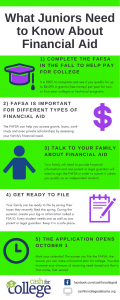As high school juniors start to consider where they want to go to college and what they want to study, there are some important steps they can take for financial aid the spring and summer before their senior year. 
It’s important that juniors are ready to complete the Free Application for Federal Student Aid (FAFSA) as early as possible when the application period opens on October 1, 2018. Why? The earlier you complete the FAFSA, the higher your chances of maximizing your financial aid.
Here are the key things high school juniors should know about the FAFSA to be prepared:
1) Completing the FAFSA this fall can help you pay for college
The FAFSA can provide up to $6,195* in free money (Pell grants) for college per year and the application is free to file! You won’t know if you qualify unless you apply.
2) There are different types of Financial Aid
One of the main benefits of the FAFSA is the Pell grant but did you know you can also qualify for work-study and different types of loans? Scholarships may also use the FAFSA to determine financial need. Learn more here.
3) It’s important to talk to your family about Financial Aid
Families need to be involved in completing FAFSA in order to submit important financial information and sign the final application in order to submit it. Unless a student qualifies as an independent, a parent or legal guardian will need to help complete the form. The FAFSA can be confusing for adults, too, so here’s a guide for them.
4) Get ready to file
The FAFSA requires applicants to submit prior-prior year tax information to assess your family’s financial need. Current high school juniors who will be attending college in 2019-2020 will complete the FAFSA beginning on October 1, 2018 and will need their 2017 tax information. These are the taxes that most families filed this spring of 2018. Save a copy of your filed taxes in a place you can easily find them to not delay completing your FAFSA application.
While students and their families cannot complete the FAFSA until October 1, they can create their log-in information known as a FSA ID beforehand. The student and at least one parent or guardian must have their own separate FSA IDs (if the student is considered a dependent). Use email addresses you will have constant access to the next four years (Not school or employer emails). Be sure to save your new FSA IDs in a safe place.
5) You can file starting October 1
Mark your calendar for October 1. The sooner you file the FAFSA, the sooner you can make a financial plan for college. You also increase your chances of receiving need-based ait that is first-come, first-served.
If you still have questions, reach out to your high school’s counselor or career coach or the financial aid office of the college you aspire to attend. Your high school counselor and career coach may also set up workshops or one-on-one appointments in the fall to help families complete the FAFSA—Ask them about their plans! For more in-depth resources, visit studentaid.gov for a complete checklist for the 11th grade.
*Note: The text was updated to reflect a $100 increase in the maximum Pell Grant award for the 2019-2020 academic year.